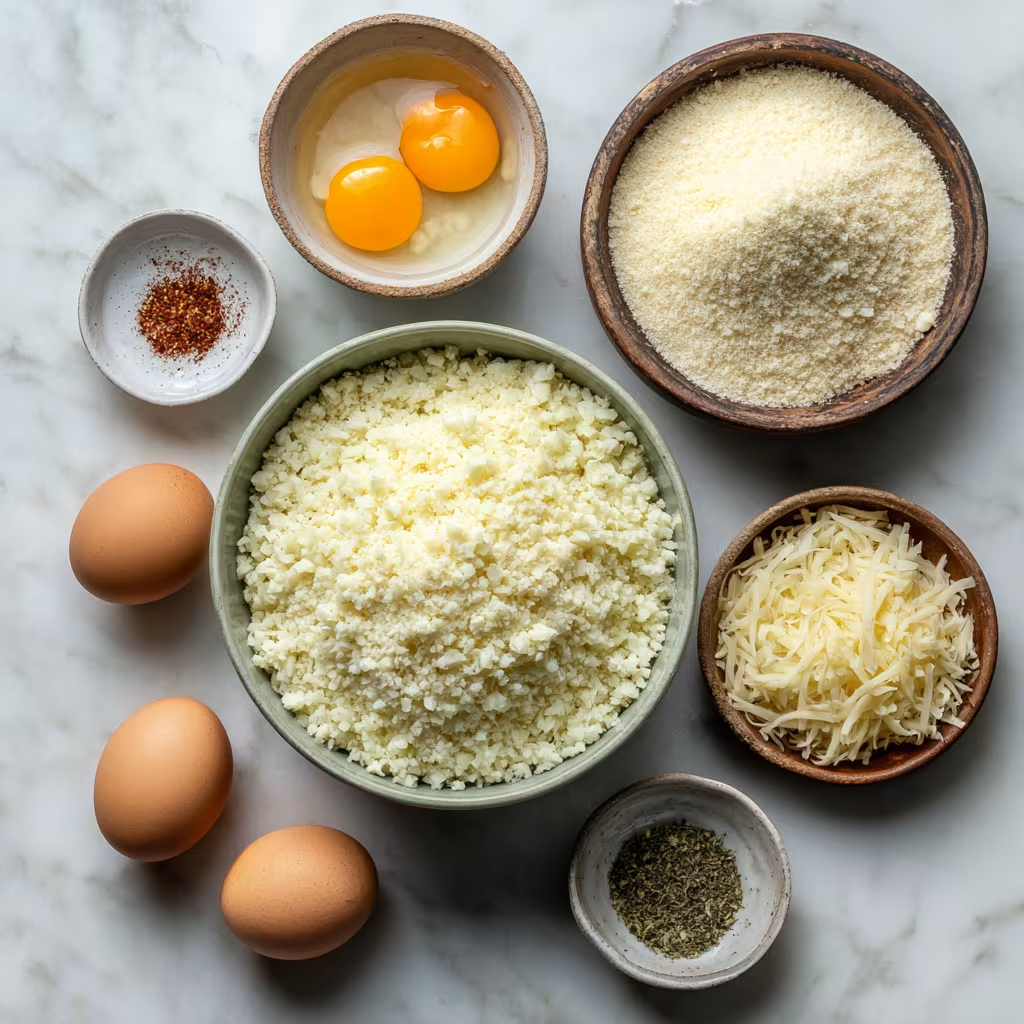Cauliflower Pizza Crust gives you all the satisfaction of a classic pizza experience with fewer carbs and more veggies. Crafting a crispy Cauliflower Pizza Crust starts with fresh cauliflower florets riced to a fine texture, then combined with eggs, cheese, and seasonings to form a dough that bakes into a golden base. This Cauliflower Pizza Crust offers a gluten‑free, keto‑friendly foundation for every topping you love—from tangy tomato sauce and melty mozzarella to roasted vegetables and spicy meats. Whether you’re meal‑planning for health or simply exploring new flavors, mastering the art of a resilient, non‑soggy Cauliflower Pizza Crust will transform how you enjoy homemade pizza night.
Health Benefits & Ingredient Prep
Cauliflower Pizza Crust shines as a healthier alternative to traditional dough. A single serving of cauliflower replaces wheat flour, cutting net carbs by up to 75 percent and delivering extra fiber and vitamins. Compared to a regular crust, a Cauliflower Pizza Crust typically contains around 5 grams of net carbs versus 25–30 grams in wheat‑based dough, making it ideal for keto or low‑carb diets. By swapping high‑glycemic ingredients for cauliflower, you also boost vitamin C, vitamin K, and folate intake, see detailed nutrition data on USDA’s FoodData Central
If you’re tracking macros, this crust supports nutrition goals without sacrificing that beloved pizza texture.
To prepare the base, start with 1 medium head of cauliflower (about 3 cups riced). Break florets into chunks and pulse in a food processor—or grate on the large holes of a box grater—until you achieve rice‑like pieces. This ricing step is crucial for a fine, uniform texture that binds properly. Transfer the riced cauliflower to a microwave‑safe bowl and cook on high for 4–5 minutes until tender. Alternatively, steam the cauliflower over boiling water for similar results.
Next, drain excess moisture—a common challenge in Cauliflower Pizza Crust recipes. Place the cooked cauliflower in a clean kitchen towel or cheesecloth and squeeze vigorously until only a few drops of water remain. Removing moisture prevents a soggy Cauliflower Pizza Crust and ensures crisp edges. If you skip this step, the crust may collapse under toppings or develop a gummy interior.
With perfectly drained cauliflower, move to mixing. In a large bowl, combine the cauliflower rice with 2 large eggs, ½ cup grated Parmesan cheese, ¼ cup shredded mozzarella, 1 tsp Italian seasoning, ½ tsp garlic powder, and ¼ tsp salt. For an extra binding boost—especially important if your cauliflower retains moisture—stir in 2 tbsp almond flour or 1 tbsp ground flaxseed. These optional add‑ins enhance structure without altering flavor, keeping your Cauliflower Pizza Crust sturdy and crisp.
For more healthy swaps, explore our Healthy Recipes collection where you’ll find other vegetable‑forward dishes. If you’re following low‑carb guidelines, check out our Keto Recipes section for inspiration on crusts and more.
Mix ingredients thoroughly, ensuring the eggs and cheese coat every cauliflower grain. The dough should hold together when pressed—if it feels loose, add a pinch more almond flour. Now you’re ready to shape and bake your first Cauliflower Pizza Crust.
Binding & Baking Techniques

A successful Cauliflower Pizza Crust relies on the right balance of binder and bake method. Once your cauliflower‑egg‑cheese mix is ready, line a baking sheet with parchment paper or a silicone mat for non‑stick release. Preheat your oven to 425 °F (220 °C).
Form the dough into a thin circle—about ¼‑inch thick—directly on the paper. An even thickness prevents underbaked centers and overly crisp edges. Bake the crust for 12–15 minutes until the edges turn golden brown and the surface feels firm. This pre‑bake step ensures your Cauliflower Pizza Crust can support toppings without becoming soggy.
If you’re concerned about sticking, lightly grease the paper with olive oil before shaping. For extra texture, sprinkle a teaspoon of grated cheese around the edge; it creates a crunchy “cheese crust” that elevates both flavor and structure.
Once the crust is set, remove it from the oven and add sauce, cheese, and toppings. Return the topped Cauliflower Pizza Crust to the oven for an additional 8–10 minutes, or until cheese melts and toppings are heated through. For a bubbly, browned finish, switch to broil for the last 1–2 minutes—watch closely to prevent burning.
For gluten‑free enthusiasts, swap almond flour for coconut flour (use 1 tbsp and add an extra egg) and replace cheese with nutritional yeast for a dairy‑free Cauliflower Pizza Crust. To explore more grain‑free options, visit our Gluten‑Free Recipes page.
Crucial tip: avoid overloading the crust. Too many heavy toppings can weigh down a Cauliflower Pizza Crust and cause it to crack or become soggy. Stick to moderate layers: sauce, ½ cup cheese, and a balanced mix of vegetables or proteins.
Freezing & Reheating Methods
One of the most convenient aspects of Cauliflower Pizza Crust is its make‑ahead potential. To freeze, complete the baking and let the crust cool completely on a rack. Flash‑freeze the plain crust on a baking sheet for 1 hour, then wrap tightly in plastic and foil before storing in the freezer. This two‑step freezing prevents moisture buildup and retains crispness. Frozen crust will keep up to 2 months.
When you’re ready to enjoy, preheat oven to 400 °F (205 °C). Unwrap the frozen Cauliflower Pizza Crust and place it on a paper‑lined sheet. Bake for 5 minutes to reheat and drive off any ice crystals, then add toppings and bake as usual. For a quick crisp, finish under the broiler for 1 minute.
If you prefer stovetop reheating, slide the crust onto a preheated, lightly oiled skillet over medium heat. Cover with a lid for 2–3 minutes, then remove, flip carefully (using a spatula), and heat toppings with residual heat. This method revives that fresh‑baked texture without using the oven.
Air fryer fans can reheat a frozen Cauliflower Pizza Crust at 375 °F for 4–6 minutes before adding toppings, then cook 3–4 more minutes. The rapid hot air circulation crisps the base remarkably well. Explore more meal‑prep strategies in our Freezer Meal Recipes and Meal Planning Tips guides.
By mastering freezing and reheating, you can batch‑bake Cauliflower Pizza Crusts on the weekend and relish homemade pizza all week long—no fuss, no soggy bottoms.
Toppings & Serving Suggestions
With your perfectly baked Cauliflower Pizza Crust in hand, the fun part begins: toppings. Classic Margherita flavors—tomato sauce, fresh mozzarella, basil leaves—complement the mild cauliflower base without overpowering it. For protein boost, scatter grilled chicken, turkey pepperoni, or Italian sausage slices sparingly to avoid weighing down the crust.
Vegetable‑loaded pizzas shine on a Cauliflower Pizza Crust. Think roasted red peppers, caramelized onions, spinach, and crumbled feta. The lower moisture content of these veggies prevents steam from softening the crust. If you crave a smoky twist, add grilled zucchini or mushrooms, but be sure to pre‑roast any high‑water vegetables.
For a gourmet spin, top your Cauliflower Pizza Crust with goat cheese, arugula, toasted pine nuts, and a drizzle of balsamic glaze after baking. This fresh topping combination highlights the crust’s crisp texture and offers a restaurant‑quality bite.
When serving, slice the pizza with a sharp pizza wheel or rocker knife to maintain square edges. Arrange slices on a wooden board or slate platter for visual appeal. Garnish plates with fresh herbs—oregano or parsley—and a sprinkle of red pepper flakes for optional heat.
Leftover slices reheat beautifully in a 375 °F (190 °C) oven for 5 minutes or in an air fryer for 3 minutes. Avoid microwaving, which creates a limp, chewy Cauliflower Pizza Crust.

FAQ
Is cauliflower pizza crust healthier than regular crust?
Yes. Cauliflower Pizza Crust cuts net carbs by about 75 percent compared to wheat dough, adds fiber, vitamins C and K, and suits keto, gluten‑free, and low‑carb diets.
How do you make cauliflower pizza crust not soggy?
Fully drain riced cauliflower before mixing. Bake the crust alone until firm, then top sparingly. Avoid overloaded, high‑moisture toppings and finish under broil for crisp edges.
Does cauliflower crust taste like real pizza crust?
A well‑made Cauliflower Pizza Crust offers a mild, slightly nutty flavor resembling thin‑crust pizza. Cheese and seasonings enhance the taste, making it satisfyingly close to traditional dough.
Do you have to cook cauliflower before making the crust?
Yes. Cooking the riced cauliflower—by steaming or microwaving—softens fibers and releases moisture for easier draining and binding, preventing a gummy Cauliflower Pizza Crust.
Can you freeze cauliflower pizza crust?
Absolutely. Bake the crust, let cool, flash‑freeze, then wrap tightly. Reheat in oven or air fryer before adding toppings for fresh‑baked crispness.
What toppings go well with cauliflower pizza crust?
Light, low‑moisture toppings like fresh mozzarella, grilled chicken, roasted peppers, spinach, or crumbled feta work best. Gourmet options include goat cheese, arugula, and balsamic glaze.
Is cauliflower pizza crust good for keto or low‑carb diets?
Perfectly. A Cauliflower Pizza Crust typically contains 5 g net carbs per serving, fitting within keto macros while offering added nutrients absent in wheat dough.
How do you keep cauliflower crust from falling apart?
Use adequate binders—eggs and cheese—and optional almond flour. Press the dough firmly and bake the crust solo until golden before adding toppings. Proper drainage and pre‑bake ensure sturdy structure.
Healthy Cauliflower Crust Pizza Recipe
- Total Time: 35 mins
- Yield: 2 (10″) crusts 1x
Description
Cauliflower Pizza Crust offers a crispy, low‑carb base made from riced cauliflower, eggs, cheese, and seasonings—ideal for keto and gluten‑free diets.
Ingredients
3 cups riced cauliflower (from 1 med. head)
2 large eggs
½ cup grated Parmesan cheese
¼ cup shredded mozzarella
1 tsp Italian seasoning
½ tsp garlic powder
¼ tsp salt
Optional: 2 tbsp almond flour or 1 tbsp ground flaxseed
Instructions
1. Preheat oven to 425 °F (220 °C). Line a baking sheet with parchment.
2. In a bowl, combine riced cauliflower, eggs, cheeses, seasonings, and optional binder.
3. Press mixture into a ¼″ thick circle on prepared sheet.
4. Bake 12–15 mins until edges are golden and firm.
5. Remove, add sauce, cheese, and toppings.
6. Return to oven 8–10 mins until cheese melts, broil 1–2 mins if desired.
7. Slice and serve hot.
Notes
Squeeze drained cauliflower thoroughly to avoid soggy crust.
Avoid heavy toppings to maintain crisp.
Freeze prebaked crust for make‑ahead meals.
- Prep Time: 10 mins
- Cook Time: 25 mins
- Category: Entree
- Method: Bake
- Cuisine: American
Nutrition
- Serving Size: 1 crust
- Calories: 180
- Sugar: 2g
- Sodium: 450mg
- Fat: 11g
- Saturated Fat: 4g
- Unsaturated Fat: 6g
- Trans Fat: 0g
- Carbohydrates: 8g
- Fiber: 3g
- Protein: 10g
- Cholesterol: 80mg
Keywords: Cauliflower Pizza Crust, low-carb pizza

